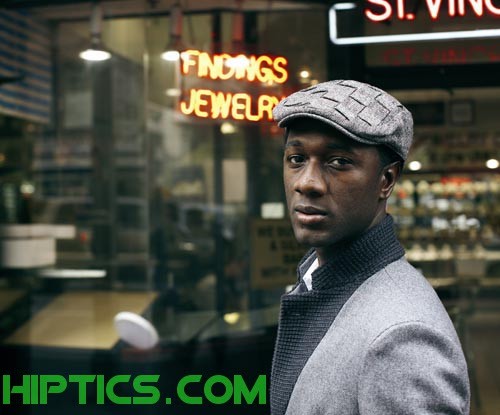
We've made no bones about our affection for Aloe Blacc in the past. There are several intriguing subjects to cover when it comes to the Laguna Hills-bred troubadour born Egbert Nathaniel Dawkins III: his days in indie hip-hop outfit Emanon; his transition from MC into a traditional soul vocalist; his upbringing by Panamanian parents; how “I Need a Dollar,” his signature track off 2010's Good Things, is the theme music to HBO's How to Make It in America. But in the interest of getting some fresh material from the guy (and previewing his date at the Detroit Bar this Saturday, May 21), we asked him a few off-the-wall questions and dug deeper into some of his comments from past interviews. Here's the sum of our efforts broken down into eight digestible points.
]
1. Although the man's known for his distinctively retro-fied
wardrobe, his fashion sense hits a dead end when it comes to wristbands, watches and necklaces. “I'm more into the jackets,
trousers, shoes and hats,” he says. His clothing pointedly ties into
his music, and said wardrobe was aided by a stylist from an L.A. company
called Via Davia Vintage. “Since the music on Good Things is very much
classic soul–late '60s, early '70s–I wanted to present myself onstage
in a way that matched the music to build a presence, to build an event,”
he adds. “The things that I liked the best was stuff that reminded me
of stuff my dad used to wear when I was a kid: leather beatle boots,
leather jackets, butterfly collar shirts, polyester shirts–those kinds
of things.” He also has a small collection of scarfs from Japan, Mexico and Russia, but he doesn't wear them onstage often anymore.
2. He despises the sound of Auto-Tune but might be willing to give
other voice synthesizers a shot. “[In the] context of Zapp &
Roger-style music with the vocoder, I think that's cool, but not so much
Auto-Tune. I can see places for voices and vocals being manipulated.
One particular example of a song that I think is tremendously great
would be Imogen Heap's 'Hide and Seek.' I'm not sure if she used
Auto-Tune, but I know she used technology to affect her voice. There are
some really good practical uses for it, but not when it's used to hide
the fact that someone can't sing.” The only way he'd ever, ever give
Auto-Tune a shot if it was for “an artistic purpose and completely
obvious and blatant.”
3. After tinkering with a handful of genres–“[f]rom Latin stuff to
acoustic guitar stuff to up-tempo dance to down-tempo R&B to some
emo-techno-whatever and children's music” –he'd
next like to take a stab at “psychedelic soul.” Elaborates Blacc: “I'd
like to do something that is a bit more edgy soul music and mixing in
some concepts I've heard from artists like Eugene McDaniels and Sly
Stone, even Jimi Hendrix or Santana, just [to] try to push the envelope
with soul music.”
4. Dude's a Ben Gibbard fan. “I wouldn't expect people to really
think that I was into something like Death Cab for Cutie or Postal
Service. I don't even know the name of the genre, really,” he
singer says, before deciding that “indie pop” and “digi-pop” could serve as
possible answers. “There's some good things coming out of a lot of
different genres. A lot of times, people don't get the recognition
'cause there's so much other crap clogging up the system.”
5. One of Blacc's first memories involving music is catching the
premiere of “Thriller” on MTV. “That was a pretty significant memory
because, of course, I was terrified, but I was excited to watch this
music video as well.” Although he's covered “Billie Jean” before, he
doesn't know if he'd dare to take on this other MJ song. “'Thriller'
might be too much of a challenge. 'Billie Jean' was just right because it
felt like it was a better way to communicate that song.”
6. “I Need a Dollar” was heavily inspired by Blacc's listening to field
recordings of men in a chain gang singing about their problems. A
friend gave him these recordings, which rely heavily on call-and-
response choruses and an uncomplicated folky feel. “I don't remember any
of the songs specifically,” he says. “It was more, for me, the general
feeling that I absorbed and the style.”
7. Aloe Blacc chose his name for smoothness' sake: the first name
references the plant associated with lotion and he exchanged the K in
“Black” for another C because he considers K a harsher consonant.
When he was still deliberating a moniker, other names included Aeolus
(which resembles Aloe) and Sirocco, two words for specific types of
wind.
8. His grandest career ambitions don't involve a specific musical
project but rather using his work for more practical results. “The
biggest thing I want to do is feed people. I'm actually able to do that
now that I'm touring,” says Blacc, referencing his ability to pay his
party of 12 that now tours with him. Otherwise, he'd like to be able to
donate considerable sums to charities and use his prominence as a
musician to affect how money-movers allot funds. “I'd like to create an
idea in corporate America and in politics that there should be a more
equitable distribution of wealth. It doesn't necessarily need to be an
even playing field where everybody makes the same amount of money. Rich
people can be as rich as they want. I just want for folks that are
struggling to have the bare necessities, and I think that's easy given
the amount of resources there are around the world to properly house and
feed and offer health care and education,” he says. “With just those
bare necessities so everybody has a fair chance in life, I think I'd be
happy.”

